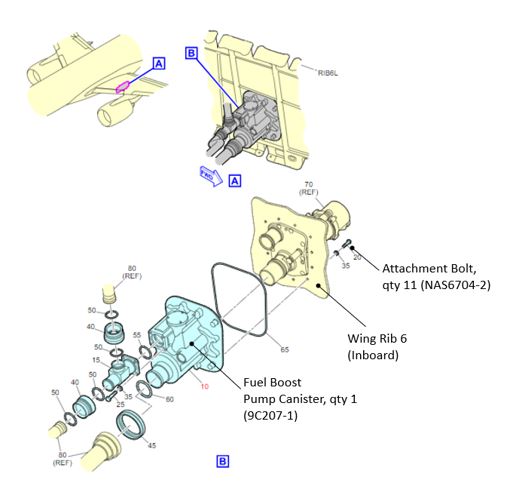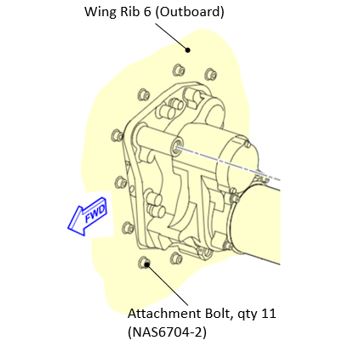Attention:
Owners, Operators and Maintainers of Airbus Canada Limited Partnership (ACLP) Aeroplanes Model BD-500-1A10 and BD-500-1A11, All Serial Numbers
| File Classification No.: | Z 5000-35 |
|---|---|
| RDIMS No.: | 20141982 |
| Document No.: | CASA 2024-04 |
| Issue No.: | 01 |
| Effective Date: | 2024-05-14 |
Purpose:
The purpose of this Civil Aviation Safety Alert (CASA) is to raise awareness of possible loose bolts at the Fuel Boost Pump Canister to Rib 6 connection, as well as missing sealant on the same bolts, and to recommend actions to correct these issues.
Background:
The Fuel Boost Pump Canister (Part Number (P/N) 9C207-1) is attached to Wing Rib 6 with eleven (11) bolts (P/N NAS6704-2) using a bolted flange connection, as depicted in Figure 1 and Figure 2. The fuel boost pump pressurizes fuel in the supply line between the tank and the engine, delivering fuel from the fuel tank to the engine driven pump. There are two (2) fuel boost pumps per aircraft, one in each wing.
Figure 1 – LHS Fuel Boost Pump Canister to Wing Rib 6 Assembly
Figure 2 – LHS Fuel Boost Pump Canister to Wing Rib 6 attachment bolts (looking inboard)
During maintenance checks on in-service aircraft, several loose bolts with broken torque stripes were discovered at the Fuel Boost Pump Canister to Wing Rib 6 interface, as well as missing sealant on the bolt heads.
Loose bolts may result in a fuel leak due to loosening of the fuel boost pump canister. The sealant applied to bolt heads provides environmental protection preventing moisture ingress and subsequent corrosion of the electrical bonding surface provided by Rib 6.
Recommended Action:
Transport Canada recommends that owners, operators, and maintainers of all BD-500-1A10 and BD-500-1A11 aircraft carry out the inspection and corrective actions, as required, described in ACLP Service Bulletin (SB) BD500-282020 Issue No. 001, dated 2 November 2023, or later revisions.
Within Canada, in accordance with the reporting requirement of Part V, subpart 21 (521) of the Canadian Aviation Regulation (CAR), owners, operators and maintainers should submit a Service Difficulty Report (SDR) to Transport Canada for the discovery of each reportable service difficulty. (Please note that if loose bolts, missing sealant, fuel leaks, or corrosion at the Fuel Boost Pump Canister to Wing Rib 6 interface is found, an SDR should be submitted). Outside Canada, report any such occurrence in accordance with local reporting requirements.
Contact Office:
For more information concerning this issue, contact a Transport Canada Centre; or contact William Humphries, Continuing Airworthiness in Ottawa, by telephone at 1-888-663-3639, facsimile 613-996-9178 or by e-mail at TC.CAWWEBFEEDBACK-retroactionWebMDLN.TC@tc.gc.ca
Original Signed By
Jenny Young
Chief, Continuing Airworthiness
National Aircraft Certification
The Transport Canada Civil Aviation Safety Alert (CASA) is used to convey important safety information and contains recommended action items. The CASA strives to assist the aviation industry's efforts to provide a service with the highest possible degree of safety. The information contained herein is often critical and must be conveyed to the appropriate office in a timely manner. The CASA may be changed or amended should new information become available.

